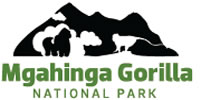The Status and Ecology of the Golden Monkey (Cercopithecus mitis kandti) in Mgahinga Gorilla National Park, Uganda.
A Report By Researcher- Sandra E. Gray
The research has now been going on for the past 2 years.
Mgahinga Gorilla National Park straddles the borders of 3 countries, Uganda, Rwanda, and Congo, and is at the heart of the Virunga Volcanoes. It is the smallest national park in Uganda. These primates are endangered and endemic to this region, sharing their home with the world famous mountain gorilla being the star attraction pulling tourists interested in gorilla tours to the remote park. There are several other primates in the park as other wildlife that include buffalo, forest elephant and other species of mammals, reptiles, amphibians and birds.
Our research group is more than 60 in number, healthy and reproducing. Their home range is montane forest and bamboo. In the beginning and for many months to follow it was very difficult to even find the monkeys owing to the fact that unlike gorillas they are small, do not make nests and leave little evidence of their presence on the forest floor, and at times can be quiet especially in the presence of their main predator the eagle. Also not been used to us they would just run away.
However, with time and a great amount of patience from myself , and the field assistants, persistence has been rewarded. The group is very much used to our presence now, allowing us to have an insight into their daily lives. The monkeys dictate how the day is going to be, and no day is ever the same in the forest. We just never know how the working day is going to turn out, and this is what makes the work so exciting.
We encounter problems regularly. One of our biggest problems is the weather.Working at an altitude of around 2,500 meters we encounter strong winds, heavy rainfall and extreme coldness, so not the best place to work in the world as far as the weather is concerned.The weather really does make a difference to how the day is going to be. Wind makes it difficult to track the monkeys as you cannot hear them, they stay quiet and in mid canopy because they have problems hearing predators and when the trees blow you do not know if it is monkey moving or wind blowing, or both. When it rains the monkeys take shelter and do not move, making it difficult for us to find them. No matter how the weather conditions are, we are in the forest every day, even Christmas day. Saying that, when it rains in the forest and the mist comes down among the moss and overhanging vegetation it is certainly the most beautiful place to be.
Buffalo can be a problem being a dangerous animal especially if with young or injured by a snare but our main threat is forest elephant and in the last few months we have seen a lot of elephant in the home range of the monkeys. The monkeys are very much disturbed by their presence as they break and destroy the trees and bamboo on which the monkeys feed.
We do come across snares from time to time, these are usually wire snares to catch duiker and bushbuck but the monkeys are at risk especially as they come down to the forest floor to search for insects and feed on bamboo shoots when they are in season.
The monkeys are just as curious about us as we are about them and they like to observe us in the same way we observe them. They are so relaxed now in our presence that at times they do not even look at us, just carry on with their daily activities.
They are social animals. The juveniles are very playful.
The more we see and learn the more questions we ask, so I hope the research will continue for many years to come.
The more knowledgeable we are the better equipped to conserve for the future.
It really is a privilege to be with such animals on a daily basis and to work in such a unique environment where so much more is to be known.

